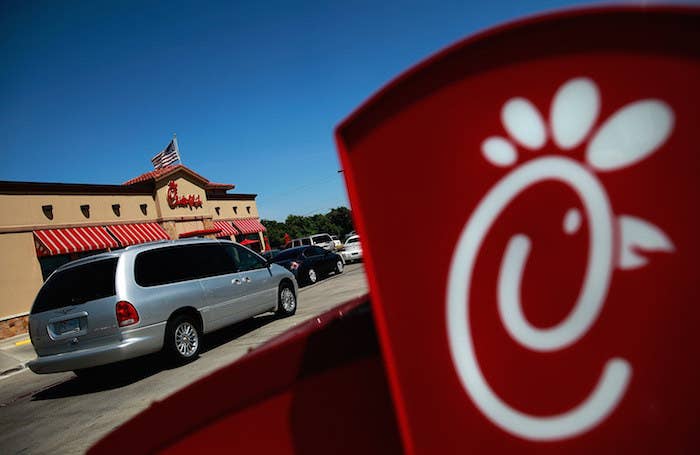
Chicken sandwich chain Chick-fil-A has experienced a tremendous surge in growth in the last few years, which has translated to extremely busy stores.
Chain-wide sales exceeded $6 billion in 2015, the Atlanta-based company told BuzzFeed News, nearly double what it made in 2009. The growth hasn't just come from opening new locations; the restaurants are doing more business too. The average store made more than $3 million in 2014, according to data from QSR magazine, compared with just $2 million in 2009.
Today, Chick-fil-A's more than 1,900 restaurants are some of the biggest moneymakers in fast food: The average stand-alone outlet (a store that's not in a food court) makes about $4.2 million per year — more than the average McDonald's or Chipotle.
The increased traffic has created epically long lines, especially at the drive-thru, where the chain still makes a majority of its money. They're the kind of lines that attract the attention of zoning commissioners when site plans are submitted and require police to direct cars when a new store opens. Then, at most Chick-fil-As, these lines just continue to be long during peak hours. On average, a Chick-fil-A drive-thru will serve 95 cars during from just noon to 1 p.m. Such problems are a blessing for any restaurant, but only up to a point. Eventually, some customers decide it's no longer worth their time.
Now the fried chicken chain is trying to design better ways to deal with growing volumes both inside and in the drive-thru.
Epic lines.
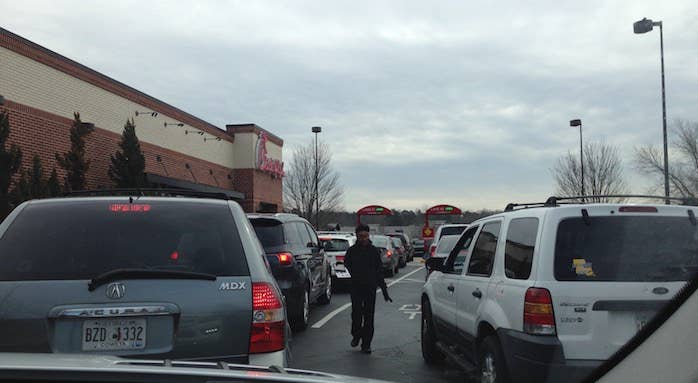
There's a HUGEE line at Chick Fil A, I ain't gonna wait for this! 😒
Don't ever go to the Waterford Lakes chick fil a drive thru. Been waiting 25 min in line and was told to go to parking space to wait longer
I'll just go to chick fil a tomorrow, that line looks wild
This critical task has fallen on Chick-fil-A's 100-plus-person innovation-and-design team.
In January, Chick-fil-A opened its third building in a little over three years dedicated to innovation and design, dubbed the "Innovation Center."
The chain opened its first design center, a 80,000-square-foot warehouse facility called "Hatch" in December 2012. The second building, called "The Kitchen," a 30,000-square-foot facility that opened in 2014, is where Chick-fil-A does most of its food development.
When Hatch opened, it was a space for exploring new store layouts, services, and kitchen operations. In addition to having a test restaurant with a functioning kitchen, designers also constructed life-size Chick-fil-A restaurants in the roomy warehouse made not of brick and tile but entirely of white foam board and fully equipped with foam board registers, foam board counters, and foam board lemonade dispensers.
The idea behind using foam board was to encourage people to pick up and move parts around during design walk-throughs before a new store is constructed to eventually arrive at a setup with better, quicker flow both in the kitchen and for customers. Models with actual equipment or sturdier walls, Chick-fil-A found, make store owners reluctant to make any tweaks. But "once you get those [foam] pieces made, it's like Legos," said Dwain Cox, Chick-fil-A's senior director of design. “We want them to be able to temporarily step outside of what they know and move into a world of ‘what could be.'"
"It's a cool space where you can do wacky things," said Stafford Green, an entrepreneur who visited Hatch in his former role as a Coca-Cola marketer. "It has the feeling of a true incubator, which a lot of companies are trying to have."
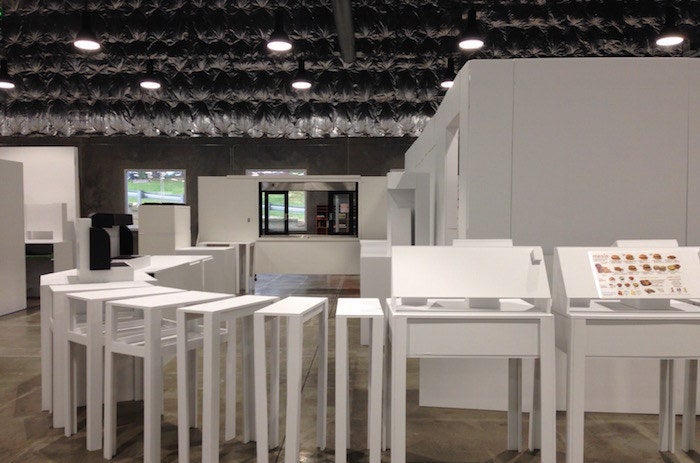
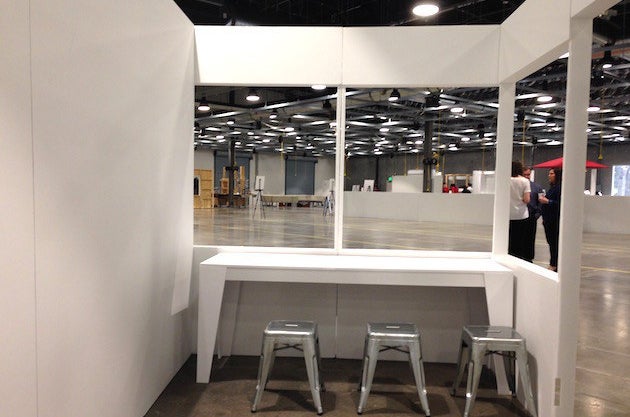
Foam models in Chick-fil-A's new Innovation Center.
With plans to open nearly 100 new locations in 2016, Chick-fil-A is doing an increasing amount of modeling work around the store and drive-thru, especially as it enters more densely populated areas where cramped real estate is demanding different store designs from what the chain normally uses. The difference of a few feet here and there could help it lease out smaller, cheaper sites.
"Every foot does matter. If we eat up three feet here, we have to find three feet somewhere else. That could be a row of parking spaces that just got sacrificed," said Eric Stogner, Chick-fil-A's manager of kitchen design.
The Hatch center was sufficient for a short while, but as Chick-fil-A opened more than 200 new locations in recent years, the design team found it was "not as big as we need anymore," said Elizabeth Snively, Chick-fil-A's senior coordinator of innovation. With too many tests in the pipeline, the chain needed more space.
This was particularly true for drive-thru work. Testers at Hatch used to ride through a fake drive-thru on bicycles, but the experience did not accurately reflect how things would operate when SUVs and trucks were pulling in and crowding the lanes.
In the new "Innovation Center," the chain has an additional 35,000 square feet to set up model stores and test new service models that will be either rolled out in new outlets or retrofitted into existing locations. (The first center, Hatch, will now be used primarily for training.) It also has room for another unusual kind of new testing: the drive-thru.
As the drive-thru is responsible for 60% of sales every year at Chick-fil-A, "this is a good one to spend money on," said Tré Musco, CEO of the San Francisco restaurant design firm Tesser (it does not work with Chick-fil-A).
With space for real cars, designers in the new Innovation Center no longer rely on bikes during simulations.


One January afternoon, a caravan of Nissan Leafs lined up inside Chick-fil-A's new Innovation Center alongside a fake indoor drive-thru that had been set up to test a new drive-thru design. The main question at hand: How narrow could the drive-thru lanes get to save space? There is also the lingering but essential question of how to move cars through more quickly, to shorten those epic lines.
To speed up service, the chain is proposing two main changes: The first is to have a team of four to six servers walk up to cars in the drive-thru to take both orders and payments via tablet, rather than having drivers wait to reach the usual pair of speakers and the cashier. This is already being tested and will launch this year, and will be continually refined at the Innovation Center. Improvements may include, for instance, adding a roof, heaters, and misters over the walking area to shield servers from bad weather.
The second is to have another set of servers walk to cars with their orders when they are ready. "The idea is to deliver food to cars even before they get to the window," said Stogner. Questions include how many feet the servers need for a walkway, and where to position the delivery window, or perhaps in the future, the delivery door. Some restaurants have been testing this service, including a location in Lexington, Kentucky that is trying the newest door design. This drive-thru delivery service likely will expand this year and next.
The chain said it hopes these changes will shave minutes off of a drive-thru customer's wait time, a huge operational improvement.
With each round, the lanes got progressively narrower and narrower. Two white drones on a counter sat ready to take off and record the process.
Chick-fil-A's drive-thru test.
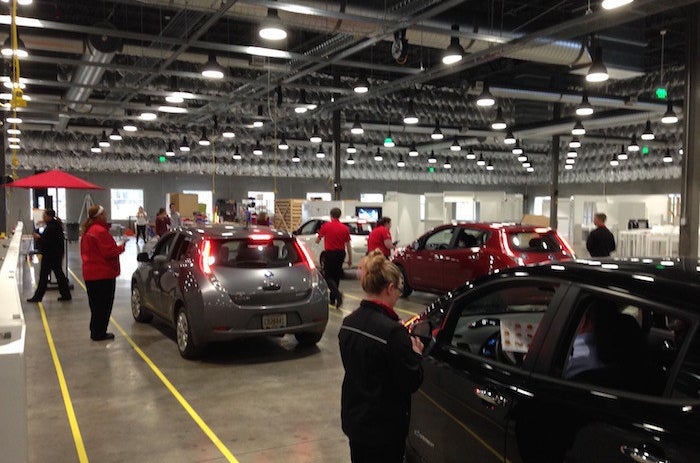
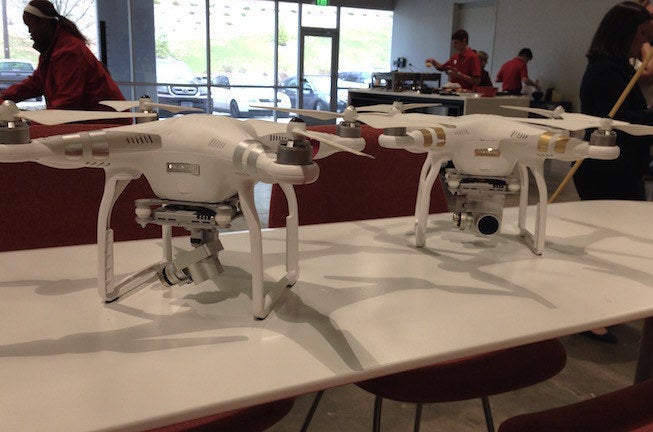
Following each round of pulling in, placing a fake order, and driving around in a loop to the pickup area, all test participants — both the drivers and the restaurant servers — gathered in a circle to provide feedback on whether the narrowing dimensions were still manageable or whether it had gotten too chaotic to maneuver.
The system Chick-fil-A is testing will doubtless add cost as it increases the number of people needed for the drive-thru. But as long as traffic to restaurants is also increasing, speedier service means Chick-fil-A can serve more customers to make up for the increased labor cost.
In addition to new stores, Chick-fil-A told BuzzFeed News it is also developing food trucks.
As it experiments with new ways to boost capacity, Chick-fil-A is also looking at food trucks, perhaps the most space-efficient businesses. The chain already has two giant trucks for promotional events, but they hand out only one thing: free chicken sandwiches.
This year, it plans to start testing two commercial food trucks that will offer a variety of items and charge money for them, with the dates and locations still to be determined.
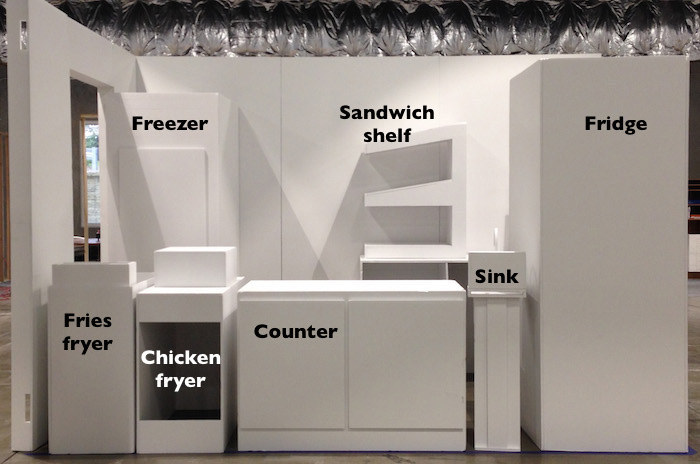
The development starts, of course, with a foam model truck in the Innovation Center. It's not on wheels, but the box has been built in the dimensions Chick-fil-A imagines it will need for a truck — roughly 9' by 12' — with foam versions of all the counters, sinks, and fridges that a real truck would require. A smaller "food van" version is being tested as well.
Designers and operators can easily reconfigure or replace the foam parts to see how many pieces of equipment it can squeeze in (for instance, whether there's space to squeeze in an ice cream machine to add dessert sales, explained Alan McKenzie, kitchen design manager), and to create the right cooking layout before building the real thing.
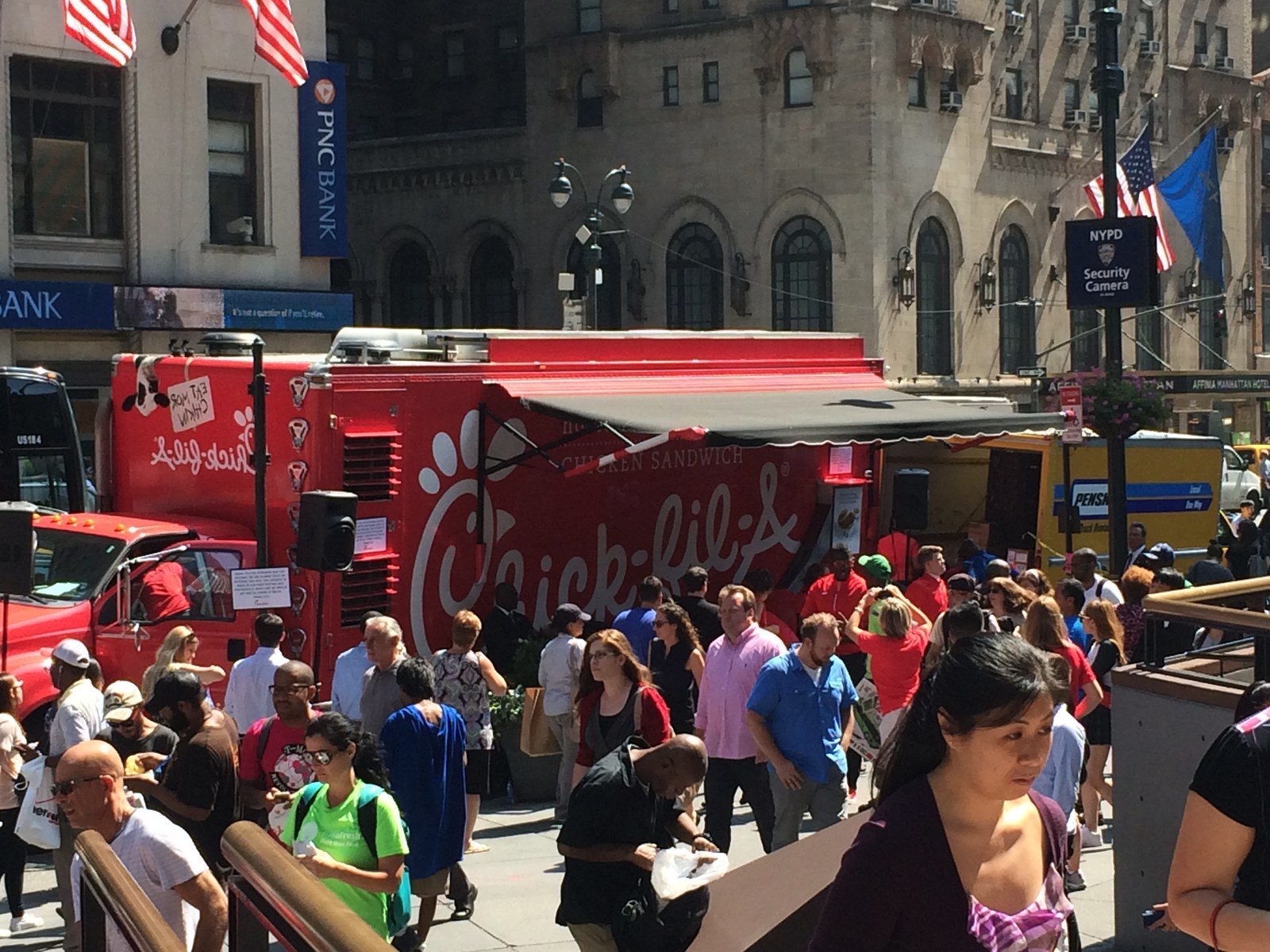
Chick-fil-A isn't the only chain with such meticulous development processes.
Design firm Tesser, which has worked with chains such as Domino's and Wendy's, describes four tiers of prototyping that typically happen during store design. The first tier is doing a digital model (which is the lowest cost); the second is a full-scale foam board model; then a wood model; then a full store. For more than half of projects, the firm gets at past the foam board stage.
"It depends on what the client wants to learn," said CEO Musco. For simple layout projects, a low-cost foam model often will do, but for completely new designs, a restaurant will probably want to see a higher-resolution build-out.
Fast food giant McDonald's also has an innovation center in Romeoville, Illinois, located in an industrial center about a half hour from its headquarters.

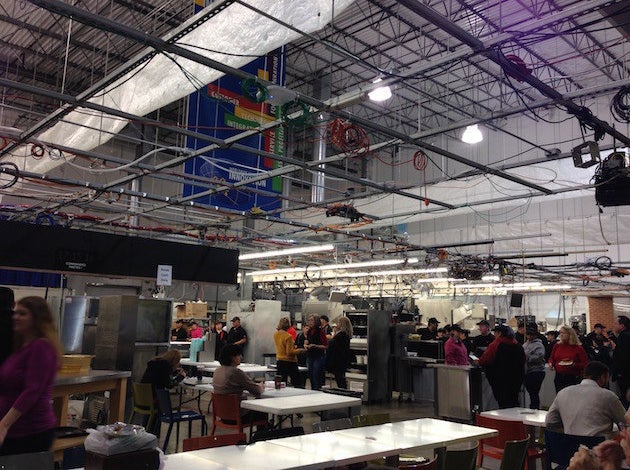
McDonald's Innovation Center in Romeoville, Ill.
McDonald's first opened an innovation center, a 5,000 square-foot-kitchen, in 1995. It has since expanded it four times to the current 38,000-square-foot facility with three kitchens that can be set up like any McDonald’s kitchen in the world. McDonald's engineers, who develop and patent new technology, are also based in the center.
Unlike Chick-fil-A's foam approach in the Innovation Center, however, McDonald's uses real equipment so it can cook food in the center. It also does not test the drive-thru with real cars.
"We have the ability with our equipment and layout to mock up any restaurant we have today, or what we want it to look like in the future, and run tests," said Laurie Gilbert, McDonald's vice president of restaurant innovation. It can also test operations for large conventions and events like the Olympics, where a kitchen may need to function differently from how it normally does — for instance, with a smaller menu and faster output.
McDonald's also trials different service models here, such as kiosk ordering or table service that are now at locations with the build-your-own burger menu, before they roll out at restaurants. Such additions — for example, making room in the restaurant for a row of kiosks — often affect the layout. The center is now working on mobile ordering in the U.S.
Teams from McDonald's around the globe travel to the innovation center to test out new technology or layouts before launching them. In late 2015, a team from Poland was at the center testing a new design for the future, as well as new menu items and how to efficiently add them. Partners in France visited McDonald's center to experiment with drive-thru improvements.
The chains have similar ambitions. "Our goal with the Innovation Center is to create the best experience possible inside the restaurant," said Chick-fil-A's Cox. "Through our prototype process, our designers and developers can push things farther than they might otherwise be comfortable with."
As Chick-fil-A tries to shorten the drive-thru line, other projects loom too. Restaurants in urban locations with no parking places or drive-thru windows "are becoming more of the norm," Cox said, and "require us to design and innovate the restaurant like never before."
CORRECTION
The drive-thru changes being tested include both ordering and paying by tablet, as well as a drive-thru delivery door. An earlier version of this story misstated the changes.
